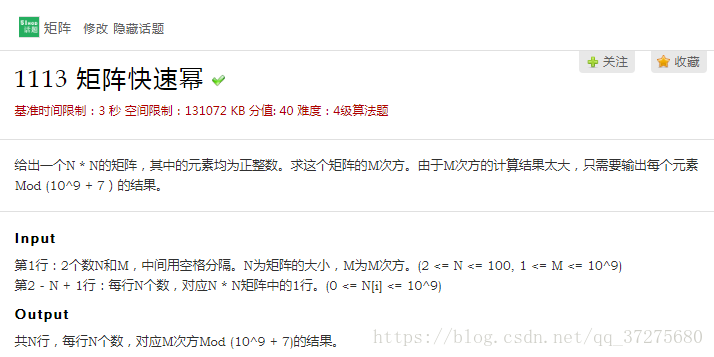传送门:51nod1113 矩阵快速幂
Input示例
2 3 1 1 1 1Output示例
4 4 4 4
今天开始学习矩阵快速幂,和之前学的数的快速幂没什么不同,只不过矩阵快速幂是以矩阵为单位的。
快速幂的原理都是二进制拆分,学习视频如下:SWPU-ACM每周算法讲堂-矩阵快速幂以及其他快速幂
相应的题目集:SWPU 2017暑假专题训练-矩阵快速幂
这个模板是视频中的大佬写的,直接拿来用了。
#include<bits/stdc++.h>
using namespace std;
typedef long long ll;
const int maxn=110;
const int MOD=1e9+7;
#define mod(x) ((x)%MOD)
int n;
struct mat{
int m[maxn][maxn];
}unit;
mat operator * (mat a,mat b){
mat ret;
ll x;
for(int i=0;i<n;i++)
for(int j=0;j<n;j++){
x=0;
for(int k=0;k<n;k++)
x+=mod((ll)a.m[i][k]*b.m[k][j]);
ret.m[i][j]=mod(x);
}
return ret;
}
void init_unit(){
for(int i=0;i<maxn;i++)
unit.m[i][i]=1;
return ;
}
mat pow_mat(mat a,ll n){
mat ret=unit;
while(n){
if(n&1) ret=ret*a;
a=a*a;
n>>=1;
}
return ret;
}
int main(){
ll x;
init_unit();
while(~scanf("%lld%lld",&n,&x)){
mat a;
for(int i=0;i<n;i++)
for(int j=0;j<n;j++)
scanf("%d",&a.m[i][j]);
a=pow_mat(a,x);
for(int i=0;i<n;i++)
for(int j=0;j<n;j++){
if(j==n-1)
printf("%d\n",a.m[i][j]);
else
printf("%d ",a.m[i][j]);
}
}
return 0;
}







 本文深入讲解了矩阵快速幂的概念及其实现,通过对比传统的数的快速幂,详细介绍了矩阵快速幂的二进制拆分原理,并提供了完整的C++代码实现,包括矩阵乘法和矩阵快速幂的模板。
本文深入讲解了矩阵快速幂的概念及其实现,通过对比传统的数的快速幂,详细介绍了矩阵快速幂的二进制拆分原理,并提供了完整的C++代码实现,包括矩阵乘法和矩阵快速幂的模板。


















 509
509

 被折叠的 条评论
为什么被折叠?
被折叠的 条评论
为什么被折叠?








